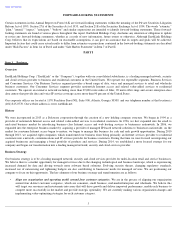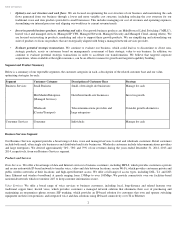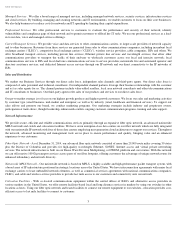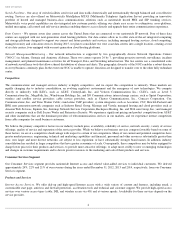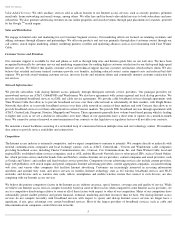Earthlink 2014 Annual Report Download - page 13
Download and view the complete annual report
Please find page 13 of the 2014 Earthlink annual report below. You can navigate through the pages in the report by either clicking on the pages listed below, or by using the keyword search tool below to find specific information within the annual report.
Table of Contents
interconnection agreements and traffic exchange with companies other than ILECs are not subject to the statutory arbitration mechanism, making
it potentially more difficult to reach any agreement on terms that we view as acceptable.
Consolidation in the telecommunications industry has significantly affected the availability of acceptable interconnection agreements that
competitive carriers such as us can adopt without incurring the expense of lengthy negotiation and arbitration with an incumbent carrier in each
state. Before their respective mergers with ILECs, AT&T and MCI dedicated significant internal and external resources to negotiate and arbitrate
interconnection agreements that many competitive carriers adopted or used as model agreements. These resources and the resulting model
agreements are no longer available as a result of consolidation among carriers, and it is likely that competitive carriers like us will be required to
invest more resources than in the past to secure acceptable interconnection agreements. The largest incumbent carriers are also attempting to
eliminate mandatory interconnection through FCC rulemaking, and replace regulated interconnection arrangements with commercial
negotiations.
Internet Protocol
-Enabled Services.
The FCC has classified cable modem services offered by cable companies and broadband Internet services
offered by wireline LECs as “information services”
and not telecommunications services subject to regulation under Title II of the
Communications Act. The FCC's policy has also been to classify narrowband Internet access services as “information services,”
which are not
subject to traditional telecommunications services regulation, such as licensing or pricing regulation. Nonetheless, the FCC has asserted
“ancillary jurisdiction”
over certain types of information services, and it is currently considering whether broadband Internet access services
should be reclassified as telecommunications services under Title II of the Communications Act, as discussed further under “
Network
Management and Internet Neutrality,” below.
The current regulatory environment for VoIP services remains unclear, as the FCC has not decided whether VoIP is an “information service”
or
“telecommunications service.”
The FCC has, however, issued a series of rulings addressing aspects of the regulatory treatment of interconnected
VoIP service, so that VoIP services that interconnect with the public switched telephone network (“PSTN”)
are now subject to a number of
regulatory requirements, including rules relating to Universal Service Fund (“USF”)
contributions, Customer Proprietary Network Information
rules, the provisioning of network access to authorized law enforcement personnel, local number portability, E-
911, outage reporting, access for
individuals with disabilities, and others. The FCC also ruled that state utility regulatory commissions may not impose pricing and entry
regulations on “nomadic”
interconnected VoIP services such as that offered by Vonage, concluding that Vonage's VoIP application and others
like it, are interstate services. Reviewing courts have affirmed these FCC decisions. Broader questions on the regulatory status of VoIP remain to
be resolved. We cannot predict how these matters will be resolved or the impact of these matters on companies with which we compete or
interconnect.
Intercarrier Compensation and Interconnection
. The FCC regulates the access rates charged by local carriers to interexchange carriers for the
origination and termination of long distance traffic. These access rates historically have made up a significant portion of the cost of providing
long distance service. In November 2011, however, the FCC adopted intercarrier compensation rules under which all traffic, including VoIP
traffic that interconnects with the PSTN, are being reduced, and a uniform bill-and-
keep framework for both intrastate and interstate terminating
access traffic will be the ultimate end state for all telecommunications traffic exchanged with a local exchange carrier. The reforms required by
the FCC's new rules are being phased in over a multi-
year transition. Since July 2013, all local carriers' intrastate tariffed terminating access
charges must be no higher than their interstate access charges. Under existing FCC rules, competitive carriers' interstate access charges may not
be greater than those of the incumbent carriers with which they compete, so the net effect of these rules is to limit competitive carriers' intrastate
access charges to the incumbent carrier's level. From now through 2018, further reductions in both intrastate and interstate terminating access
charges and reciprocal compensation rates are required, with an ultimate end state of bill-and-
keep (that is, a rate level of zero) for all transport
and termination charges. These new rules significantly alter the manner in which all carriers, including us, are compensated and pay for the
origination and termination of telecommunications traffic. We expect these new rules to result in a loss of revenues and potentially to increase
our volume of carrier disputes. Several states, industry groups, and other telecommunications carriers filed petitions for review of the FCC order,
which were consolidated in the United States Court of Appeals for the Tenth Circuit. The Tenth Circuit denied these petitions, affirming the FCC
order. A petition for certiorari has been filed with the United States Supreme Court, requesting review of the Tenth Circuit’
s opinion. The
outcome of this petition is unpredictable.
The FCC also issued a Further Notice of Proposed Rulemaking (“FNPRM”)
in November 2011 which asks for further input on many issues
relating to interconnection and traffic exchange, including whether incumbent carriers have an obligation under the 1996 Act to provide
competitors like us with IP-to-IP interconnection for the exchange of voice traffic at any technically feasible point in their networks on non-
discriminatory, cost-based terms. While the FCC rulemaking order states an “expectation that parties will negotiate in good faith”
toward IP to
IP interconnection agreements, the FNPRM asks questions about the legal framework that should govern these interconnection arrangements,
which creates some potential uncertainty regarding whether these arrangements will be economic.
8





